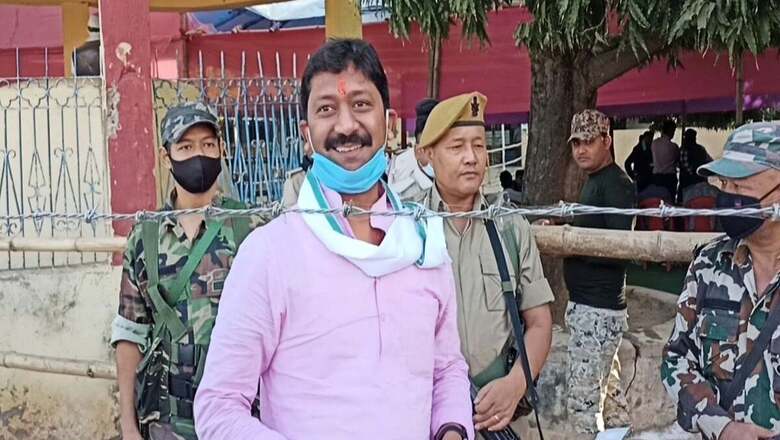
views
Sumit Kumar Singh will be the lone Independent candidate to enter Bihar Legislative Assembly in the just concluded polls. Thirty-nine-year-old Singh defeated RJD’s Savitri Devi by a slender margin of 581 votes from Chakai Assembly seat in Jamui district.
However, more than getting elected as an MLA, his importance lies in making it to the Assembly as the only Independent, that too in a state known for its unconformity with the established and prevailing political mood, be it opposition to Emergency or handing out defeat to NDA in 2015 Assembly polls.
For the first time since Independence, just one candidate won the Assembly polls without any party affiliation. Bihar, like many other states, has been witnessing a steady decline in number of Independents making it to the legislature.
Bihar (then undivided) chose 33 Independent MLAs in the 1967 Assembly Polls, the highest in the state ever. Even in 1990, the Assembly which elected Lalu Yadav as CM for the first time, 30 Independents made it to the Assembly.
However, things are in a downturn since then. Tweleve Independents won in 1995, which rose to 20 in 2000, the last Assembly election of undivided Bihar with 324 seats.
In 2005, Bihar witnessed two state polls, in February and another one in October, electing 17 and 10 Independent MLAs respectively. This was the last time Independents’ number was in double digit, though at a lower end. Just six MLAs won as Independents in 2010, four in the last Assembly polls and one this time around.
“It’s not a good sign in a healthy democracy,” feels Professor Sanjay Kumar, Co-Director of the Lokniti programme at CSDS. “We have party system in India. If someone doesn’t get a party ticket, he/she at least has an option to contest as an Independent,” he says.
“There are many independent-minded people who want to serve public but don’t prescribe to the party system,” Sanjay Kumar explains saying, “this result will discourages such people who will be left with no choice but to stand behind a party to participate in the political process”.
Agrees 42-year-old Prabhash Chandra Sharma, who unsuccessfully contested as an Independent candidate from Patna’s Bankipur Assembly seat. “I was ready to give an alternative. I am in social work for the last 12 years and have uploaded record of my work on social media,” says Sharma who got 127 votes. He had also contested last Lok Sabha polls from the Patna Sahib seat in 2019.
So why are Independents losing the poll game? Isn’t there a need for smaller constituencies to make contest affordable and easier for public to approach their elected representatives?
“Not that all nirdaliya lack money,” asserts Sharma but “party cadre is more important than money” to win a poll.
Sharma gets the backing of Ram Nath Mahto who claims to have ran a “sabse sasta campaign” (the most economic campaign) during the Assembly polls. Mahto, a former BJP worker and a lawyer in Patna City court, unsuccessfully contested as an Independent candidate from Patna Sahib Assembly seat and garnered 1,148 votes, the most by any Independent from the seat.
“My total expenditure was just Rs 1.08 lakh and that too collected from crowd sourcing,” boasts Mahto. “100 crore jo kharch karega, wo janta ki seva kya karega (How can a person spening Rs 100 crore serve the people),” he asks, taking a pot-shot at money bags in the poll fray.
“Nirdaliya (Independents) ke andar bhi seva karne ka jajba hai, lekin garib ka beta kaise chunav ladega, kahan se 30 lakh laayega,” Mahto concluded alluding to Rs 30.8 lakh Assembly poll expenditure limit fixed by the Election Commission.
“Not just big, fact is poll constituencies are drawn in a haphazard manner to suit entrenched political parties and players,” complains Rajeshwar Ray, who contested from Raghopur Assembly seat against RJD’s Tejashwi Yadav.
Centre for the Study of Developing Societies (CSDS)’s Professor Sanjay Kumar too agrees about the size of Assembly seat albeit from a different perspective. “How much should the size of a constituency be reduced is a subject of debate because it will also lead to increase in people’s representatives,” he says. Smaller constituencies help public get in touch with their representatives easily, stated Kumar.
But isn’t technology a leveller and is democratising the poll contest? “Not always,” says Padma Narayan Jha ‘Viranchi’, a political veteran and advisor to the former UP chief minister HN Bahuguna. “Technical advancement and new campaigning tools like social media favours the “biggies”, both parties as well as individuals.”
Explaining further he says that “it is similar to the formula of cluster-based economic growth where a region already with better resource is more likely to grow faster, compared to others when fed with stimuli.” With the same set of technological tools, an organised party is more capable of enhancing its influence compared to Independents, Jha argues. “Technology favours all, but rich and organised ones first,” he concluded.
Read all the Latest News, Breaking News and Coronavirus News here




















Comments
0 comment